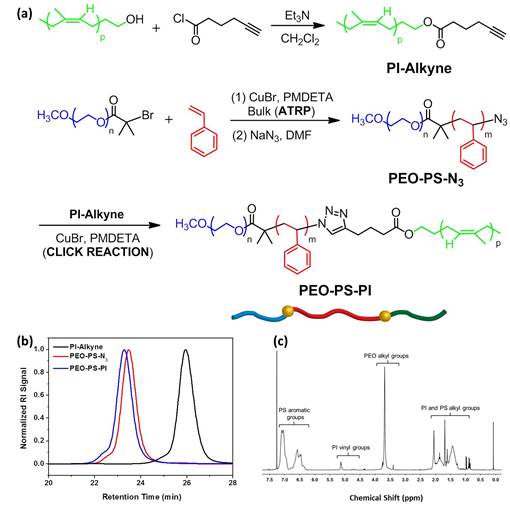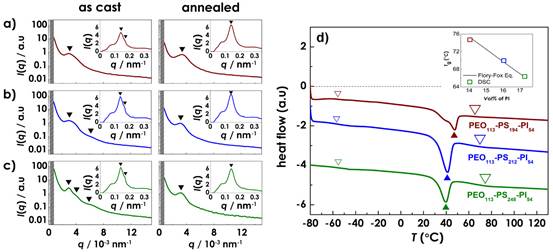Reports: DNI752701-DNI7: Square Arrays of Cylinders in Thin Films of Symmetric ABC Triblock Copolymers
Chuanbing Tang, University of South Carolina
A series of linear poly(ethylene-b-styrene-b-isoprene) (PEO-PS-PI or OSI) triblock copolymers containing nearly equal volume fractions of PEO and PI (fPEO ˜ fPI) and various fractions of the middle PS block (70.8vol% = fPS = 75.6vol%) were prepared in order to systematically investigate the influence of different compositions on the self-assembly in bulk and thin films. The synthetic strategy combined atom transfer radical polymerization (ATRP) and click chemistry, as outlined in Figure 1a. Monomodal GPC traces with an increase in molecular weight were obtained for each sequential chain extension (Figure 1b). The representative 1H NMR spectrum shows all the relative integrals of each block. The experimental data for OSI systems is described in Table 1.
Figure 1. (a) A synthesis procedure for PEO-PS-PI triblock copolymer. (b) GPC traces and (c) 1H NMR spectrum of OSI3 (CDCl3).
Table 1. Characteristics of the PEO-PS-PI triblock copolymers.
Figure 2. SAXS intensity profiles of (a) OSI1, (b) OSI2, and (c) OSI3. (insets) The corresponding WAXS intensity profiles. (d) DSC curves of OSI1-3. (inset) Experimental Tg value of PS/PI (open squares) and calculated value with the Flory-Fox equation (solid line).
The morphology and thermal properties of bulk films was probed with the aid of SAXS, WAXS, DSC. OSI3 exhibits higher order peaks (Figure 2a-c) that are consistent with the presence of a periodic microdomain morphology. The three peaks are corresponding to q/q* values of 1,v2, v4, consistent with a BCC structure. The WAXS data reveal the presence of monoclinic crystal polymorph of PEO. DSC data clearly reveal a glass transition (Tg = -55 °C) and melting point (Tm = 47~40°C) for PEO block. A shallow glass transition is observed in the temperature range of 65~76 °C that is indicative of softening of a mixed PS/PI domain and the dependence of this shallow Tg on the mass fraction of PS and PI in the copolymer is consistent with the Flory-Fox prediction of a uniformly mixed PS/PI blend system (see inset of Figure 2d). The analysis presented above suggests that bulk films exhibit a microphase separated structure of PEO microdomains immersed within a PS/PI background.
Figure 3. (a-c) AFM height images with Voronoi diagram overlay of OSI3 thin films. (d-f) GISAXS measurements (left) and simulations (right) for OSI3 at ai = 0.19°. (g-i) In-plane line cuts from GISAXS data for OSI3. These data were acquired at ai = 0.2°.
Additionally, the thin film ordering of these triblock copolymers was investigated using a high-humidity solvent (toluene) annealing process, both with and without low concentrations of a lithium salt. Both the AFM and Voronoi (Figure 3a-c) results clearly exhibit that (1) PEO domains arrange with hexagonal symmetry; (2) lithium salt swells the lattice, increasing both the size and periodicity of PEO domains. GISAXS was used to measure the structure of OSI3 films. The in-plane shape of the first-order peak for each system was fit to a Gaussian function (Figure 3d-f). The lateral ordering measured with GISAXS is consistent with the AFM Voronoi analysis. For all cases, detected peaks are consistent with in-plane hexagonal symmetry. There is layering of the spheres through the film thickness. The change in packing symmetry from bulk BCC to thin film hexagonal is a well-known consequence of confinement.
(2) Industry-Benign Solvent Annealing Process
Industry benign solvents, methyl ethyl ketone (MEK) and propylene glycol monomethyl ether acetate (PGMEA), were implemented to achieve ordered films. A linear diblock copolymer poly(ethylene oxide)-block-polystyrene (PEO-b-PS) was used with a molecular weight of 18,000 Da and a PEO fraction of 28.0 wt% and a dispersity of 1.10. Thin films were subjected to high humidity solvent annealing using three solvents toluene, PGMEA, and MEK.
Figure 4: AFM height images of think film block copolymer PEO-b-PS processed by high humidity solvent annealing in: toluene (A); PGMEA (B); and MEK (C). GISAXS measurements for annealed films in toluene (E); PGMEA (F); and MEK (G) at (ac ˜ 0.16º).
AFM images of all films showed highly ordered domains on the surface. A long solvent anneal with PGMEA generated highly ordered film with hexagonally packed domains. Similar to PGMEA, solvent annealing with MEK produced ordered films of hexagonally packed domains. GISAXS scattering profiles indicate the formation of cylinders. However, they did not persist throughout the film from the observation of broad “streaks” along the af axis at all incident angles. This indicates a thin surface structure dominates the scattering. The in-plane scattering peaks for toluene and PGMEA indicate hexagonal packing, however for MEK the scattering profiles are consistent with parallel cylinders. We conclude that hexagonal dimples at the film surface are a result of parallel cylinders that perforated at the top.
Research Impact:
(1) Our finding on mixing of PS and PI in OSI polymers verified some of earlier assumptions made by the Bates group and Morse group; The use of industry-benign solvents makes the solvent annealing process one step further toward commercialization.
(2) The PI (Chuanbing Tang) was promoted to associate professor with tenure in June 2014. Dr. Alper Nese, a postdoc supported by this grant, recently found a scientist position at Sila Nanotechnologies. A 4th-year Graduate student, Jeffery Hayat, is continuing to work on this project. Dr. Yali Qiao, partially supported by this grant, just finished her postdoc work in the Tang group. Eric Leonhardt, an undergraduate student, worked on this project for nearly two years in the Tang group, and recently went to graduate school at Texas A&M to work with Karen Wooley.
















